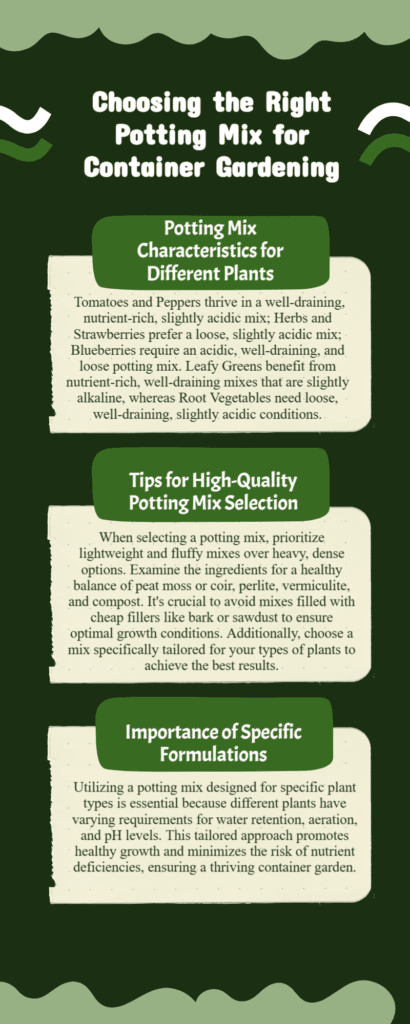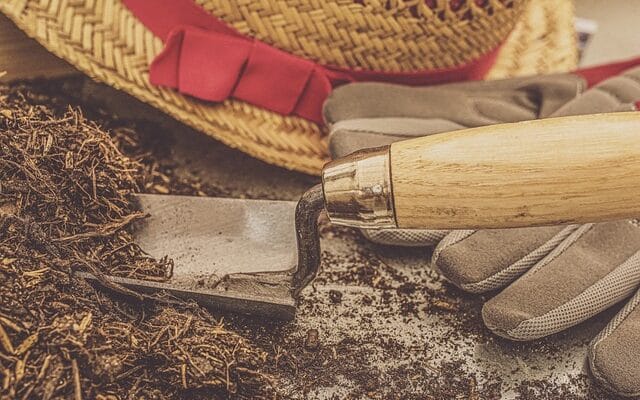Disclosure: This post may contain affiliate links, meaning we get a commission if you decide to make a purchase through our links, at no cost to you. See our full disclosure here.
Hey there, fellow dirt divas and dudes!
Let’s face it: we’ve all been there – staring at our plants and wondering why they’re not thriving as they should. Well, I’m here to tell you that one of the biggest secrets to success in container gardening is choosing the right potting mix. It’s the foundation of your plant’s growth and can make all the difference in your yield and overall plant health. However, there are many options, and potting mix differences matter.
Why Garden Soil Just Won’t Cut It in Containers
Now, you can grab some soil from your backyard and call it a day. But let me tell you, that’s a recipe for disaster. Garden soil is heavy and dense, leading to poor container drainage and compaction. This means your plants’ roots won’t get the oxygen they need and will be more susceptible to diseases. You’ve probably wondered why some dirt sets like concrete in a pot. It’s because soil in pots doesn’t work.
What is Potting Mix and Why is it So Important?
Potting mix is a unique blend of ingredients designed specifically for container gardening. It’s lightweight and well-draining and provides the perfect balance of nutrients and support for your plants. Think of it as the ultimate spa treatment for your roots!
The Magic Ingredients of Potting Mix
Most potting mixes contain a combination of ingredients, such as peat moss or coco coir, perlite, vermiculite, and compost. Each ingredient is crucial in creating the ideal environment for your plants.
Types of Potting Mixes: Finding the Perfect Match for Your Plants

General Purpose Potting Mix:
This is your basic, all-around potting mix, suitable for a variety of plants. However, you might need to amend it for heavier feeders like tomatoes and peppers or for water-sensitive plants like herbs and strawberries.
Soilless Mixes:
These mixes are made from peat moss or coco coir. They are popular for container gardening because they’re lightweight and provide excellent drainage. However, since soilless mixes don’t contain nutrients, you’ll need to fertilize your plants regularly.
Compost-Based Mixes:
Compost is an excellent addition to any potting mix because it’s rich in nutrients and helps retain moisture. However, the quality of compost can vary, so it’s important to choose a reputable source.
Mixes for Specific Needs:
Suppose you’re growing plants with specific needs, like heavy feeders, water-sensitive plants, or acid-loving plants. In that case, you can find potting mixes specially planned for them. For example, mixes for tomatoes and peppers often contain added nutrients or slow-release fertilizers, while mixes for herbs and strawberries have extra perlite or vermiculite for improved drainage.
Amending Your Potting Mix: Customizing for Your Plants’ Needs
Even if you start with a good quality potting mix, you can amend it to meet the specific needs of your plants. Some common amendments include perlite or vermiculite for drainage, compost or worm castings for nutrients, slow-release fertilizers for a steady supply of nutrients, and lime for adjusting pH.
Don’t be Fooled by Bagged Soil
Just because it comes in a bag doesn’t mean it is a potting mix. Some bags say garden soil and should never be put in a container. Some bags will say raised bed container mix, which should never be used in a container. You must be careful when it says potting soil, as soil should never be used in pots. You want only products that say potting mix and preferably ones that say “soilless potting mix.” This is why knowing potting mix differences is so important.
Troubleshooting Potting Mix Problems: Don’t Let These Issues Rain on Your Parade
Nutrient Deficiencies:
Suppose your plants show nutrient deficiencies, like yellowing leaves or stunted growth. In that case, you might need to adjust your fertilization routine or amend your potting mix with additional nutrients.
Over-watering/Under-watering:
The wrong potting mix can contribute to over-watering or under-watering problems. If your mix is too dense, it can retain too much moisture, leading to root rot. On the other hand, if your mix is too loose, it might not hold enough moisture, causing your plants to dry out quickly.
Pest and Disease Issues:
Some potting mixes can be more susceptible to pests and diseases than others. For example, mixes that contain too much peat moss can be attractive to fungus gnats. If you’re having problems with pests or diseases, repot your plants with a fresh batch of potting mix.
Compaction:
Compaction is a common problem in container gardens, especially if you’re using a heavy potting mix or not repotting your plants regularly. Compacted soil can prevent roots from getting oxygen, leading to stunted growth and other problems. To prevent compaction, you can repot your plants every year or two and add amendments like perlite or vermiculite to improve drainage.
Choosing the Right Potting Mix: Your Guide to Success
Here’s a quick cheat sheet to help you choose the right potting mix for your container garden:
| Vegetable/Fruit | Potting Mix Characteristics |
| Tomatoes, Peppers | Well-draining, nutrient-rich, slightly acidic |
| Herbs, Strawberries | Well-draining, loose, slightly acidic |
| Blueberries | Acidic, well-draining, loose |
| Leafy Greens | Well-draining, nutrient-rich, slightly alkaline |
| Root Vegetables | Loose, well-draining, slightly acidic |
Tips for Choosing High-Quality Potting Mix:
- Look for a lightweight and fluffy mix, not heavy and dense.
- Check the ingredients list to ensure a good balance of peat moss or coir, perlite, vermiculite, and compost.
- Avoid mixes that contain a lot of fillers, like bark or sawdust.
- Choose a mix specifically formulated for the type of plants you’re growing.
Remember, gardening is a personal journey, and there’s no one-size-fits-all answer with potting mix. Experiment and find what works best for you and your plants!
Potting Mix Differences: The Foundation of Your Gardening Success
Choosing the right potting mix is one of the most important things you can do to ensure the success of your container garden. Understanding the different potting mixes and their characteristics can create the perfect environment for your plants to thrive. So get your hands dirty and grow your own way!
What’s your favorite potting mix for container gardening? Share your tips and tricks in the comments below!
#dirtdivadiaries #growyourownway #pottingmix #containergardening
Disclaimer: This post is for informational purposes only and should not be construed as health, wellness or nutrition advice. Please see our full disclaimers here.


Leave a Reply